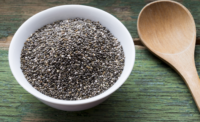There’s a reason why better-for-you is trending and “perfect-for-you” isn’t. According to the August 2018 “U.S. Better for You Eating Trends” market report from Mintel, just 7 percent of consumers say they’re strict with themselves to make sure their diet is as healthy as possible, and just three in 10 say they maintain a healthy diet most of the time.
When it comes to today’s consumers, balance is key, with 38 percent saying their diet is a mix of healthy and not-so-healthy eating, and another 73 percent agreeing that indulgences are permissible in a healthy diet.
But perhaps that healthy portion is growing its share of stomach. Nearly half of consumers say they’re purchasing more healthy food today than they were a year ago. They want to eat better. They’re trying. And snack producers and bakeries have a significant opportunity in front of them.
“The bakery has always been a natural home for indulgence, both savory and sweet,” says Matt Patrick, technology, applications research and technical services, Delavau Bakery Partners by SafPro, Piscataway, NJ. “As people seek to balance indulgence with healthier options, bakers have a major opportunity to deliver.”
Indeed, snack manufacturers and bakers have a number of sub-trends to choose from, as better-for-you encompasses all kinds of attributes—from non-GMO and organic to nutrient fortification, simple ingredients, minimal processing and more. What do all of these factors have in common? Reading the label.
“Today’s consumer is more aware of and educated on the ingredients in their foods—they understand which ingredients should raise red flags and which ingredients earn a seal of approval,” says Daniele Bianchini, foodservice director of customer and brand marketing, Otis Spunkmeyer, Los Angeles. “As a result, consumers have become hyper-aware of nutrition labels when considering what to buy. Because of this, nutrition labels and ingredients are driving the latest better-for-you trends in the snack and bakery space.”
On the shelf, Otis Spunkmeyer appeals to these trends with its the Grab ‘N’ Go portfolio, a line sold exclusively to convenience stores and made up of individually packaged foods that satisfy label readers and accommodate on-the-go snacking. It’s been formulated with the brand’s “No Funky Stuff” promise, which means the products are formulated without artificial flavors, colors, partially hydrogenated oils or high-fructose corn syrup.
For Otis Spunkmeyer, the idea was removing unwanted ingredients and replacing them with natural ones. It was a challenge, but one that has paid off as better-for-you trends and label scrutiny only continue to grow.
Natural cues
As consumers shift away from processed foods and artificial ingredients, many consumers prefer to eat products that are as close to their natural state as possible, says Victoria De Bruin, marketing manager, U.S. Highbush Blueberry Council, Folsom, CA.
According to Nielsen’s “Individual Snacking Categories on the Rise in the U.S.” report, snacks with non-GMO claims grew by 18.2 percent in five years, and snacks free from artificial colors and flavors grew by 16.2 percent, as compared to an average growth of 1.2 percent across the entire snack category.
One way to appeal to the natural ingredient trend is to offer “snackfections,” which De Bruin describes as a new hybrid category combining traditional confections with snacks. “This new hybrid integrates sweetness, saltiness and texture from a range of ingredients, such as chocolate, fruit, nuts, seeds and more,” she explains, making it easy to incorporate natural ingredients.
Blueberries can bring much to such products. Not only are blueberries a clean-label ingredient that consumers recognize, but dried blueberries, blueberry powder and blueberry flakes can be used in products to add natural flavor, natural color and texture, De Bruin says. Bonus: The moisture content from the ingredients adds texture and flavor to gluten-free baked goods and snacks.
Corn can also bring natural color. Suntava Purple Corn, from Healthy Food Ingredients, Fargo, ND is available in formats like flour, meal, grits and more, thus meeting the demand for functionality that snack and bakery manufacturers are looking for with high levels of anthocyanins and antioxidants and clean label with natural color, says Jennifer Tesch, chief marketing officer.
Adding nutrients
From fiber to protein and beyond, better-for-you shoppers often want products that provide some sort of health benefit. That said, not all consumers are seeking out these ingredients for identical health goals. “Gut health may be what millennials are looking for in higher-fiber products, whereas blood sugar management and digestive wellness may be something that baby boomers seek,” says Katie Harris, product development and nutrition scientist, Bay State Milling Co., Quincy, MA. The good news is that ingredient suppliers are stepping up to offer all kinds of bakery- and snack-friendly nutritional options appropriate for a variety of applications.
HealthSense High Fiber Wheat Flour from Bay State Milling is made from a specific variety of high-amylose wheat—one that’s also Non-GMO Project Verified—that delivers gut-nourishing resistant starch fiber. “Unlike regular starch, resistant starch does not get digested in our body, and thus it doesn’t contribute to blood sugar,” explains Harris. “This is an important characteristic for those with diabetes or prediabetes.”
Another better-for-you option from Bay State Milling is SowNaked oats, a hull-less oat variety. It’s higher in protein than traditional oats, but still allows manufacturers to deliver food products with a familiar ingredient.
Delavau Bakery Partners by SafPro helps brands achieve glass-of-milk levels of calcium in baked goods. “For example, we’ve delivered a glass-of-milk level of calcium in a six-inch sandwich roll, while maintaining a desirable and enjoyable sensory experience,” says Patrick. “Our Accent 6500 system, in particular, delivers a sodium reduction benefit and calcium fortification in baked goods, contributing important fortification while reducing sodium levels in bakery applications.”
Orafti chicory root fiber from BENEO, Parsippany, NJ, can increase fiber content, while also reducing added sugar and fat content, in many snack and bakery products. “At only 2 kcal/gram, chicory root fiber enables food manufacturers to produce fiber-enriched and reduced-calorie versions of traditionally indulgent baked goods and snacks such as cereal bars, baked goods and fillings,” says Kyle Krause, product manager, functional fiber and carbohydrates, North America.
Citrus fiber can also bring multiple benefits—functional and nutritional—to snacks and baked goods. Citri-fi from Fiberstar, Inc., River Falls, WI is produced using a patented mechanical profess that opens up the fiber to create high surface area and emulsification properties, says Jennifer Stephens, vice president of marketing. It’s non-GMO, gluten-free, allergen-free and suitable for clean-label product development as it can be listed on ingredients legends as “citrus fiber,” “dried citrus pulp” or “citrus flour.”
Diet-friendly
In today’s better-for-you marketplace, the term “diet” no longer exclusively refers to weight loss. Indeed, Paleo, vegan, gluten-free, allergen-friendly, keto and other diets are impacting nearly every aisle of the supermarket, and the snack and bakery sections are no different. “One thing manufacturers know is that consumers will always look for the next new diet to improve their overall wellbeing,” says Stephens. “This has been going on for decades and will continue to fuel new product development.”
Rice starch is an excellent ingredient for creating indulgent textures, especially in fat-free or fat-reduced products, says Krause. “Rice starch granules mimic the feeling of fat in the mouth and provide a creamy texture and decadent mouthfeel with little or no fat in the formula.” Additionally, it works well in gluten-free products and can give developers control over a wide range of textures, from smooth and creamy to crisp and crunchy.
There’s no need to compromise sweetness and mouthfeel when it comes to cakes, cookies and other sweet goods, thanks to BENEO’s sugar replacer, isomalt. According to Krause, it’s the only sugar replacer derived from pure sugar beet. Therefore, it has a sugar-like taste with only about 50 percent of the sweetness of sucrose. Plus, it’s sugar-free, low-glycemic, low-calorie, tooth-friendly and replaces sugar at a one-to-one ratio.
Plant-based momentum
More consumers are switching to plant-based diets, or simply adding more plant-based alternatives of their favorite foods because they recognize them as better for their health—and for the planet. “While consumers are switching to plant-based diets, they may not want to give up their favorite foods that are normally made from animal products,” says Harris.
And plant-based eating goes well beyond the popular plant-based burgers on the market, says Mark Stavro, senior director of marketing, Bunge Loders Croklaan, Chesterfield, MO. Options about to include plant-based options for all eating occasions, meaning there are significant opportunities for snacks and baked goods to meet that trend, he says.
But not all plant-based ingredients are always equally appealing. BungeMaxx sunflower lecithin, which doesn’t require allergen labeling in the U.S., is non-GMO and serves as a replacement for soybean lecithin. “Plant-based and vegan brands know their consumers read package labels and ingredients lists,” says Stavro, “and that they also have high expectations for taste and texture.”
Blue Diamond Almond Global Ingredients Division, Sacramento, CA, offers Almond Protein Powder for use in a variety of snacks and baked goods. The ingredient is clean-tasting and plant-based, and its high protein content comes from a recognizable ingredient: almonds.
“In addition to being gluten-free, Blue Diamond Almond Protein Powder is also dairy-free, soy-free and non-GMO, making it well suited for consumers with a range of dietary needs,” explains Jeff Smith, director of marketing, Blue Diamond Almonds Global Ingredients Division. When combined with Blue Diamond Almond Flour, manufacturers can create protein-fortified versions of traditional baked goods, including breads, muffins, cookies, bars and crackers.
Whether striving for subtle or dramatic better-for-you impacts across snack food and bakery categories, today’s product developers have a sizeable toolbox of solutions available to them to help formulate the next generation of appealing—and incrementally nutritious—foods.






